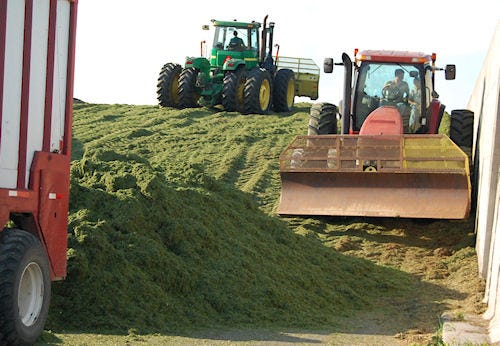July 4, 2011

Many Northeast dairy farmers are just glad to finally have their corn crop in the ground and growing. But a cooler and wetter than normal growing season spells more challenges for putting high-quality silage in the bunkers.
Heat, temperature and light are key factors in determining fiber digestibility, explains Kevin Putnam, Pioneer dairy specialist. Cool and wet conditions lower neutral detergent fiber digestibility.
Knowing individual field conditions and hybrid maturities helps growers pick the appropriate harvest date. Harvest is typically six to 10 days away when the crop is about 3% to 5% wetter than optimal.

BUILDING BUNKER FEED VALUE: Silage inoculants plus proper packing will be needed to maximize this year's corn silage feed value.
Outside factors such as weather and field location can affect the rate of maturity and ideal moisture levels for harvesting forage. Additional harvest timing and chopping tips can be found in the Pioneer nutritional sciences library at www.pioneer.com.
Normal packing density recommendations suggest you strive for an average packing density of 15 pounds of dry matter per cubic foot or better. But Putnam recommends getting that number closer to 17 dry matter pounds to improve efficiencies.
"By increasing dry matter density by another 2 pounds, producers potentially save another 1.5% dry matter from oxygen penetration," he explains. "Dry matter loss isn't fiber; it's carbohydrates like sugar. So figuring the cost of the loss requires calculating the cost of replacing that 1.5% with an energy source such as cornmeal."
Silage packing tips
First, strongly consider using a silage inoculant. That's solid insurance aimed at locking in the best possible feed value via speedy and proper fermentation.
Proper packing guidelines begin with layering silage at 6 inches or less across the bunk. And, Putnam suggests following the rule of 800 when packing.
Multiply the number of tons coming in each hour by 800. That represents the total pounds of tractor-weight needed for packing. "If you're bringing in 100 tons per hour, that means using 80,000 pounds of tractor for packing per hour."
Invest in plastic to cover the forage. Putnam also suggests lining bunkers with plastic to reduce losses along sidewalls. Wrapping that plastic over the top can double protection on top.
It's a way to reduce shrinkage losses and improve dry matter recovery. What's it worth?
Putnam offers this straightforward calculation: With 1,000 tons of silage in a bunker and shrink reduced by 5%, you save 50 tons. If corn silage is worth $45 a ton, you can save $2,250 on 1,000 tons.
If you use cornmeal to replace energy source losses, the calculation is slightly more complicated. Fifty tons of corn silage at 34% dry matter is 17 dry matter tons. If cornmeal is 86% dry matter, this means you need 19.76 tons of cornmeal to replace the lost dry matter. If cornmeal costs $280 per ton, then saving 5% dry matter could save $5,532.80.
For more on bunker management, contact your local Pioneer dairy specialist or visit www.pioneer.com/forages.
You May Also Like




